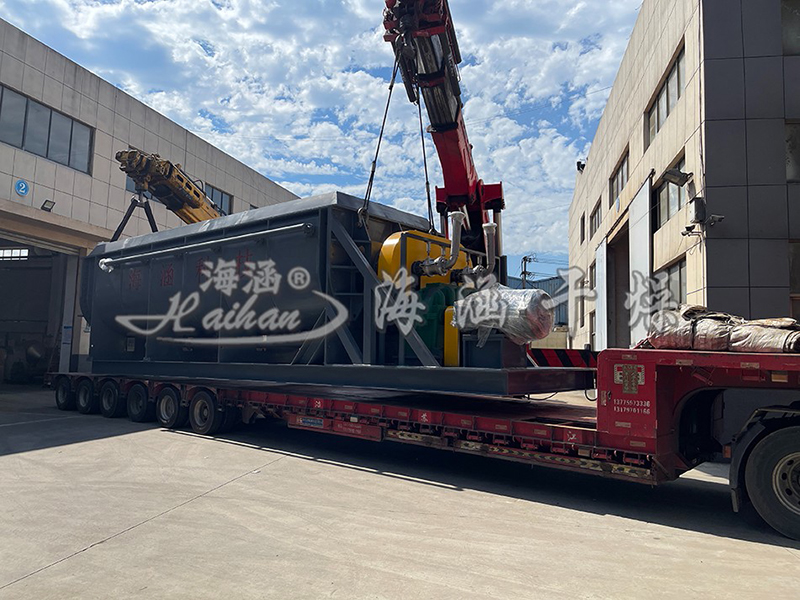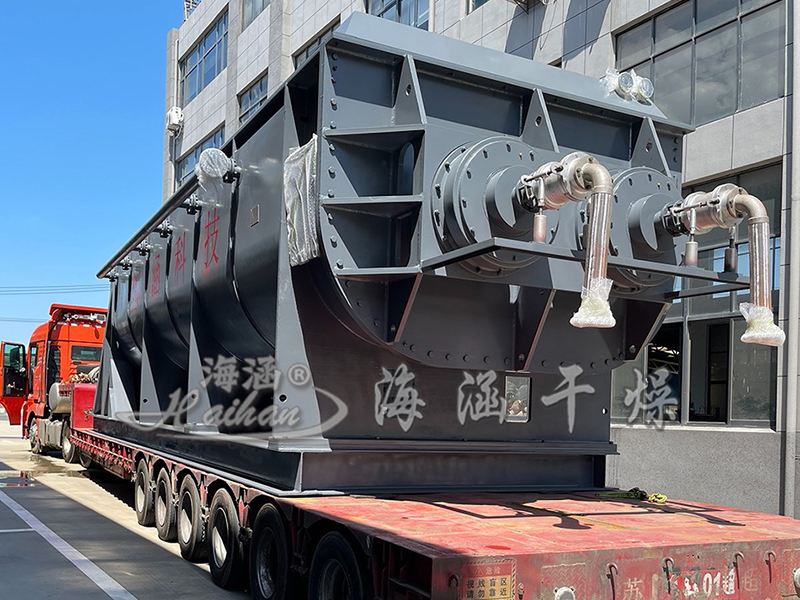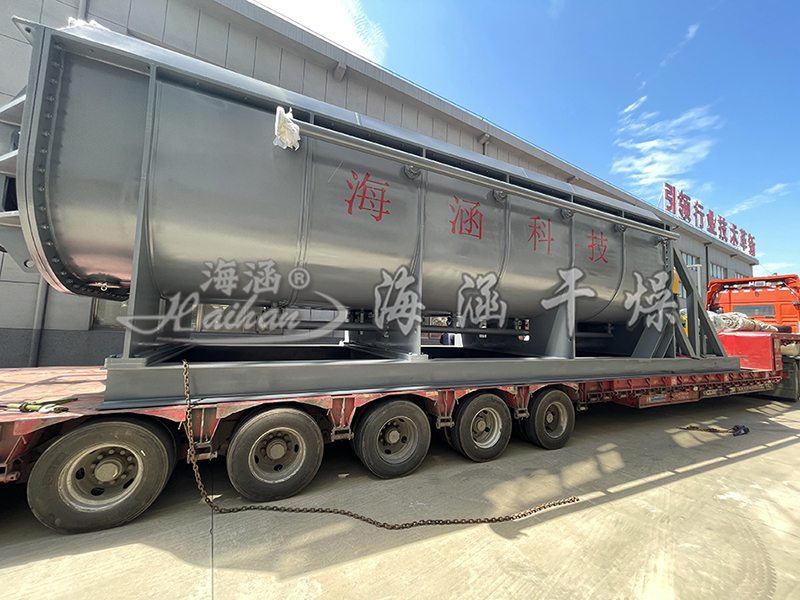The sun is blazing, the summer is hot, and recently the temperature in Changzhou has refreshed the perception of heat again and again.
The weather is so hot that it feels like the whole earth is burning, and heat waves are rolling everywhere.
But even this hot weather is not hot.
Changzhou Haihan Drying Equipment Technology Co., Ltd. colleagues to ship the enthusiasm of the work.
Product introduction:
Hollow paddle dryer is a kind of horizontal mixing type continuous drying equipment mainly based on heat conduction. Because the heat required for drying relies on indirect heating by heat conduction, the drying process does not need or only needs a small amount of gas to take away the moisture. It greatly reduces the part of heat loss taken away by gas flow, improves the heat utilisation rate, and is a kind of energy-saving drying equipment. Paddle dryer is widely used in petrochemical, chemical, metallurgy, food, medicine, pesticide and other industries in the powder, granular, filter cake, slurry material drying.
Working Principle:
Hollow paddle dryer heat transfer surface has several parts such as blade, stirring shaft, wall, and the heat transfer area of the blade accounts for a large part, so the equipment has a compact structure and large heat transfer area per unit volume. In addition, stirring and mixing make the material flip violently, so as to obtain a high heat transfer coefficient, so the floor space and space are very small, saving the cost of plant infrastructure. Drying process gas dosage is less, the flow rate is low, the amount of dust taken away by the gas is less, so it is convenient to recover the gas dust after drying, and the volume of the recovery equipment is small, so it can save the investment in equipment. For the drying process which needs to recover solvent, the concentration of solvent can be greatly improved. Due to the special structure of paddle, the material receives squeezing and relaxation alternately in the drying process, which strengthens the drying. The filling rate of the material inside the drying chamber is very high, which can reach 80%-90%, and the residence time of the material can be adjusted by adjusting the charging speed, stirring shaft rotation speed, the filling degree of the material and other parameters, which can be adjusted arbitrarily from a few minutes to a few hours. In addition, the material in the dryer from the feeding port to the discharge port movement is basically a piston movement, residence time distribution is narrow, so the product moisture content is uniform. The paddle has a certain axial angle on the mixing shaft, so the material can be dried continuously.
Equipment structure:
Take the double shaft type as an example to introduce its structure (hollow paddle dryer can be divided into single, double and four) . It consists of a W-shaped shell with jacketed ends, the upper cover, two hollow shafts with blades, end caps at both ends, rotary joints through the medium, metal hoses, and including gears, sprockets and other components of the transmission mechanism.
The core of the equipment is two hollow shafts and hollow stirring paddles welded on the shafts. The shape of the paddles is a wedge-shaped hollow semicircle, which can be passed into the heating medium. In addition to the role of stirring, but also the equipment of the heat transfer body. The two main heat transfer sides of the paddle blade are bevelled, so when the material is in contact with the bevelled side, with the rotation of the blade, the particles quickly slide away from the bevelled side, so that the heat transfer surface is constantly updated and heat transfer is strengthened. At the bottom of the triangle of the paddle blade there is a scraper to scrape up the material deposited on the bottom of the shell to prevent dead space.
The row layout of the paddle and the size of each part have certain requirements, and in the feeding area, drying area, discharge area in addition to the paddle, another auxiliary institutions to ensure stable operation of the machine, drying uniformity. In addition, the residence time can be adjusted.
The main features of the equipment:
1、Compact structure of the equipment, large effective heat transfer area and small footprint.
2、Uniform mixing, high thermal efficiency, good drying effect.
3、Paddle shafts can engage with each other, with self-cleaning effect, can prevent the material from sticking to the wall.
4、Low energy consumption, small operating costs
5、Small dust entrainment, less material loss.
6, indirect heating, no contaminated material
7、Low rotating speed of paddle shaft, without destroying the shape and nature of the product.
8、Equipment operation flexibility, smooth and reliable operation.
Scope of application:
Paddle dryers have been successfully used in food, chemical, petrochemical, dyestuff, industrial sludge and other fields. The heat transfer, cooling and stirring characteristics of the equipment enable it to perform the following unit operations: calcination (low temperature), cooling, drying (solvent recovery), heating (melting), reaction and sterilisation. Stirring The paddles are also heat transfer surfaces, which increases the heat transfer area per effective volume and shortens the processing time. The wedge-shaped paddle heat transfer surface is also self-cleaning. Compression-expansion stirring function to make the material mix evenly. Material along the axial into the ‘piston flow’ movement, in the axial zone, the material temperature, humidity, mixing degree gradient is very small.
With thermal oil as the heat medium, paddle dryer can complete the low-temperature calcination work. For example: Calcium sulfate dihydrate (CaSO4-2H2O) calcined into calcium sulfate hemihydrate (CaSO4-1/2H2O). Sodium bicarbonate (NaHCO3) calcined into soda ash (Na2CO3) and so on.
Cooling medium, such as water, cooling brine, etc. can be used for cooling. For example, the paddle-type cooling machine used in the soda ash industry replaces the old-fashioned air-cooled cooling machine, which saves energy and exhaust gas treatment equipment, reduces operating costs, and can also be used for titanium dioxide, nickel-iron alloy powder and a variety of powdered and granular materials cooling. In a single machine can be cooled from 1000 ℃ material to less than 40 ℃.
The most important function of the drying equipment, without the use of hot air, so that the solvent recovery, energy consumption, environmental control in the ideal state of easy to handle. The need to recover solvents, flammable and easy to oxidise thermosensitive materials are particularly adaptable. Has been widely used in fine chemicals, petrochemicals, dyes industry.
The uniformity of temperature, humidity and mixing in the axial zone makes the equipment usable for heating or melting, or for some solid material reactions. It has been successfully used in compound fertiliser and modified starch industries. Paddle dryers can be used to sterilise food and flour. The large heating area in the unit effective volume quickly heats the material to the sterilisation temperature, avoiding the change of material quality by long time heating.
1、Petrochemical industry: polyolefin powder, polycarbonate resin, high and low density polyethylene, linear low density polyethylene, polyacetal particles, nylon 6, nylon 66, nylon 12, acetate fibre, polyphenylene sulphide, propylene-based resins, engineering plastics, polyvinyl chloride, polyvinyl alcohol, polystyrene, polypropylene, polyester, polyformaldehyde, styrene ~ acrylonitrile copolymer, ethylene ~ propylene copolymer.
2、Environmental protection industry: PTA sludge, electroplating sewage sludge, boiler soot, pharmaceutical factory slag, sugar factory slag, monosodium glutamate factory slag, coal ash.
3、Feed industry: soy sauce residue, bone-based feed, wine lees, food scraps, apple pomace, orange peel, soybean meal, chicken bone feed, fish meal, feed additives, biological sludge.
4、Food industry: starch, cocoa beans, corn kernels, salt, modified starch, pharmaceuticals.
5、Chemical industry: soda ash, nitrogen, phosphorus and potassium compound fertilizer, kaolin, bentonite, white carbon black, carbon black, phosphogypsum, sodium oxide fluoride, nitric acid, calcium, magnesium carbonate, sodium cyanide, aluminium hydroxide, barium sulphate, calcium sulphate, calcium carbonate, dyes, molecular sieve, saponin.










